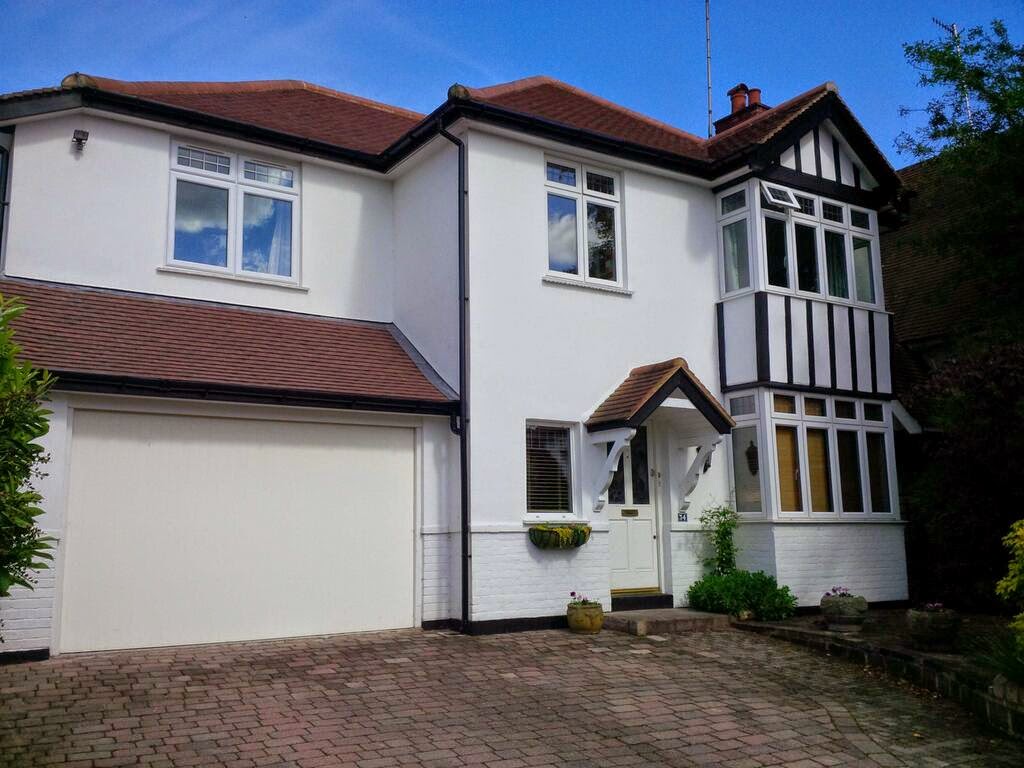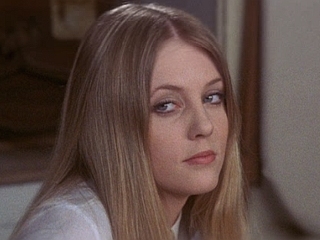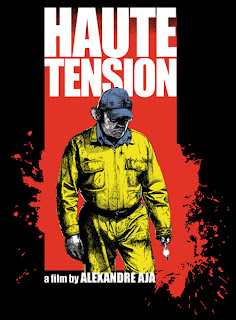Margaret Lockwood: Darling of Suburbia - Part 1
 |
| Lockwood's former home: 34 Upper Park Road, Kingston ©Richard Halfhide |
Nor
for that matter did she possess the caustic tongue of Louise Brooks, something borne out by the somewhat placid serialised account of her life Lockwood gave to the long-running fan magazine Picturegoer across five weeks between March and April, 1950.
 |
| Picturegoer, March 25, 1950 ©IPC Media |
A comeback - the spy film Highly Dangerous - was already in pre-production but it seems likely that these articles had been conceived as a means of keeping Lockwood in the public eye during this screen hiatus. Despite being only 33 Lockwood's very provincial brand of stardom was about to be supplanted by a younger, brasher generation of actresses who weren't afraid to flaunt their charms in a manner in which she would have surely demurred. Ironically Picturegoer itself would become renowned for its cheesecake covers of bikini-clad starlets over the next decade.
"British films have not always given Margaret Lockwood a square deal, but she has always given them rather more than value for money."
Popular appeal is crucial to understanding Margaret Lockwood's success. Between 1946 and 1948 she won the public vote in three consecutive Best Actress prizes at the Daily Mail National Awards, a precursor of sorts to the BAFTAs. A public appearance tour in 1945 drew hysterical responses from her devoted, largely female, fan base.
However the critical establishment treated Lockwood with at best ambivalence and sometimes outright hostility, particularly in the wake of the Gainsborough dispute. Film scholar Bruce Babbington, in his essay ''Queen of British hearts': Margaret Lockwood revisited' suggests this was largely due to fears about the "feminisation" of British cinema generated by the success of the Gainsborough melodramas.
Lockwood's supporters such as Leonard Wallace, ghost writer of these memoirs, were truculent in their defence. "You only have to work with Margaret Lockwood to realize very quickly there's not an ounce of conceit in her... British films have not always given [her] a fair deal, but she has always given them rather more than value for money" he notes in his introduction.
Another was Daily Express feature writer Eve Patrick who devoted an entire article admonishing the increasingly vindictive attacks on Lockwood: "For too long now has Margaret Lockwood been a sitting target and general Aunt Sally for every would-be wisecracker."
To those only partially aware of the Lockwood cannon the criticisms do seem uncharitable and perhaps a little perplexing. My own perception was shaped by the vivacious young starlet of Hitchcock's The Lady Vanishes, where in both character and performance she was more than the equal of Michael Redgrave during their screwballesque exchanges. Lockwood's natural, unaffected manner in that film seems to anticipate the egalitarian, less class conscious spirit that would emerge during and after the war.
But while watching a number of Lockwood films over the course of the past year I would come to realise that neither is the The Lady Vanishes especially representative of her career. In fact, taken as a whole, as an actress she's deeply frustrating...
L et's go back to the beginning. Margaret Mary Lockwood Day was born in Karachi, then India, in 1916. The Raj still firmly held dominion and Lockwood's father, an Englishman, was an administrator for the railways. Her mother, Margaret Evelyn Lockwood, a redoubtable Scot, wearied of their itinerant life on the subcontinent and decided to return to the UK, bringing Margaret and Margaret's elder brother, Lyn, with her. So peripheral does Margaret's father become thereafter that they were effectively a single parent family.
They eventually settled in Norwood, south London, within a stone's throw of Sydenham Park and the Crystal Palace. At that time a small and fragile-looking child, Lockwood showed little academic prowess but some promise as a performer prompted Margaret Sr. to enrol her daughter in stage school.
In an age when our celebrity-fixated culture is taken to task for inspiring unrealistic notions of a fast track to fame and fortune one ought to bear in mind this is really nothing new and a theatrical career was by no means frowned upon for a young lady. "Don't put your daughter on the stage Mrs Worthington," Noel Coward sang in his 1933 lament of pushy mothers attempting to thrust their less-than-capable progeny into the limelight.
Ironically Lockwood, blossoming into anything but an "ugly ducking", made one of her earliest stage appearances in Coward's Cavalcade, a tenure cut prematurely short when she made the innocent mistake of repeating to her mother some of the playwright's fruitier backstage banter, prompting Mrs Lockwood to withdraw her from the production.
Lockwood makes light of the incident in Picturegoer but it's an early hint as to the troubled relationship she would have with Margaret Sr. which would eventually lead to outright hostility and a breakdown of all relations, something detailed at length in Hilton Tims' 1989 biography Once a Wicked Lady. Nevertheless when, at sixteen, Lockwood announced her desire to become a professional actress, it was her mother who arranged her audition with RADA.
She was accepted and made, by her own account, "rapid progress" during her two years at the Academy. Another significant development was Lockwood's signing with manager Herbert de Leon, who would become her lifelong mentor and confidante. De Leon had the honour of first introducing Lockwood to Alexander Korda... who politely declined the opportunity to recruit the young ingenue (a mistake Korda would later recount he'd also made with Marlene Dietrich).
Unperturbed, the agent arranged a screen test for her at the British International Pictures studio at Shenley Road, Elstree, where her once luxurious eyebrows were shaved off at the insistence of the cameraman, never to return. The test footage was shown to director Basil Dean who initially cast her in a small role in a production of Lorna Doone. As with so many star biographies fate then played its hand; when second lead Dorothy Hyson was taken ill Lockwood was promoted to the larger role.
Curious to note here that Lockwood recalls being "about twenty-two" when her lucky break took place. In fact Lorna Doone was made in 1934 and she was still just eighteen. It seems odd that Lockwood should have such a hazy recollection of the formative years of her career. I'm going to hazard a guess that it was an unconscious slip, because at "about twenty-two" Lockwood would make a decision that irrevocably changed her relationship with her mother...
Lorna Doone was followed by four years of solid if unspectacular progress in middling quota quickies such as The Case of Gabriel Penny and Who's Your Lady Friend? One important alliance she formed during this period was with a young director named Carol Reed, whom Lockwood had first encountered as the assistant director on Lorna Doone.
When Reed came to make his directorial debut the following year with the breezy sea adventure Midshipman Easy he made good on a promise to cast her. Their next film together, Who's Your Lady Friend? was, by all accounts, a disappointment but Reed kept faith (albeit under duress from the studio chiefs) and in 1937 cast her again in one of the sadly forgotten gems of pre-war British cinema: Bank Holiday...
Bank Holiday depicts a typical long weekend in the late 1930's and an ensemble of loosely connected people, of various ages and backgrounds, who flock to the fictitious seaside resort of Bexborough (Brighton by another name). The film has a warmth and naturalism that breaks away from the creaky staginess of most British drama hitherto, yet appears presciently aware that the way of life it depicts will soon come to an end. A newspaper billboard at the beginning bears the legend "WAR CLOUDS OVER EUROPE", although at the time filming began (September 1937) it was still two years away.
Lockwood plays Catherine Lawrence, a nurse who has developed a friendship with an expectant father, Stephen Howard (John Lodge), who is left distraught when his wife dies during labour. Torn between remaining to console Stephen or meeting with her fiance Geoffrey (Hugh Williams), who has designs on spending a dirty weekend on the south coast. She goes, but as events conspire to thwart Geoffrey's intentions Catherine finds herself reassessing their relationship, rushing back to London to check on Stephen just in time to prevent him taking his own life.
 The relaxed, confident nature of her performance, compelling in her confliction, not to mention radiantly beautiful, ranks among the best of Lockwood's career. That she doesn't dwell on the film in greater length says much about the personal tumult with which it coincided.
The relaxed, confident nature of her performance, compelling in her confliction, not to mention radiantly beautiful, ranks among the best of Lockwood's career. That she doesn't dwell on the film in greater length says much about the personal tumult with which it coincided.
She had known Rupert Leon (no relation to Herbert) since she was seventeen and it was during the making of Bank Holiday that the couple decided to marry. "It was to be a quiet wedding at a registry office, with no publicity and no photographers." Lockwood recounted (in fact it took place in Epsom, barely 200 yards from where I'm writing this).
The key detail she omits is that her mother had known nothing about it. It wasn't until the following March that a reporter who had heard rumours of a secret marriage would break the news to Margaret Sr., leading to a harrowing confrontation. Hilton Tims, who interviewed Lockwood at length in the late eighties, wrote of the incident: "It was the first time Margaret had seen her mother in tears. On and on Margaret stormed. How could she have been so ungrateful and deceitful? She had brought shame on them all." Although a peace of sorts would be established the betrayal left permanent scars.
It's hardly surprising of course that the whiff of anything scandalous was airbrushed out of Lockwood's history. That her marriage to Rupert broke down not long after the birth of their daughter Julia in 1942 is also not touched upon at all during the articles, although it would have been widely known by 1950.
When Reed came to make his directorial debut the following year with the breezy sea adventure Midshipman Easy he made good on a promise to cast her. Their next film together, Who's Your Lady Friend? was, by all accounts, a disappointment but Reed kept faith (albeit under duress from the studio chiefs) and in 1937 cast her again in one of the sadly forgotten gems of pre-war British cinema: Bank Holiday...
Bank Holiday depicts a typical long weekend in the late 1930's and an ensemble of loosely connected people, of various ages and backgrounds, who flock to the fictitious seaside resort of Bexborough (Brighton by another name). The film has a warmth and naturalism that breaks away from the creaky staginess of most British drama hitherto, yet appears presciently aware that the way of life it depicts will soon come to an end. A newspaper billboard at the beginning bears the legend "WAR CLOUDS OVER EUROPE", although at the time filming began (September 1937) it was still two years away.
 The relaxed, confident nature of her performance, compelling in her confliction, not to mention radiantly beautiful, ranks among the best of Lockwood's career. That she doesn't dwell on the film in greater length says much about the personal tumult with which it coincided.
The relaxed, confident nature of her performance, compelling in her confliction, not to mention radiantly beautiful, ranks among the best of Lockwood's career. That she doesn't dwell on the film in greater length says much about the personal tumult with which it coincided.She had known Rupert Leon (no relation to Herbert) since she was seventeen and it was during the making of Bank Holiday that the couple decided to marry. "It was to be a quiet wedding at a registry office, with no publicity and no photographers." Lockwood recounted (in fact it took place in Epsom, barely 200 yards from where I'm writing this).
The key detail she omits is that her mother had known nothing about it. It wasn't until the following March that a reporter who had heard rumours of a secret marriage would break the news to Margaret Sr., leading to a harrowing confrontation. Hilton Tims, who interviewed Lockwood at length in the late eighties, wrote of the incident: "It was the first time Margaret had seen her mother in tears. On and on Margaret stormed. How could she have been so ungrateful and deceitful? She had brought shame on them all." Although a peace of sorts would be established the betrayal left permanent scars.
It's hardly surprising of course that the whiff of anything scandalous was airbrushed out of Lockwood's history. That her marriage to Rupert broke down not long after the birth of their daughter Julia in 1942 is also not touched upon at all during the articles, although it would have been widely known by 1950.
Professionally the secret marriage did no harm to Lockwood's growing reputation. Shortly after she was cast in The Lady Vanishes, a role which consolidates the easy assurance she'd displayed in Bank Holiday. However, while she is complimentary of the film (and paints a fairly typical picture of Hitchcock and his attitude toward his cast) she expresses frustration being "simply a nice girl. I hadn't yet had much chance to act on screen".
Those chances - and a shot at Hollywood stardom - would soon present themselves. In fact the next two years, more so than her early successes or the glories that were to come at Gainsborough, would reveal much about Margaret Lockwood.




As a child I lived at 10 Upper Park Road with my extended family and my grandmother cleaned Margaret Lockwood's house. I was taken there when she was away on holiday and could not believe the number of toys in the nursery and what was in the 1950s a very manicured style of living a far cry from anything I had ever seen before. I think this was one of several impressions that contributed to my nascent understanding of class in Britain during the period.
ReplyDeleteMany thanks for that recollection. From what I've read of Lockwood's childhood after arriving in England the family weren't particularly wealthy and Margaret Sr. was probably quite frugal. Lockwood wasn't herself particularly extravagant in her lifestyle but I can imagine she pampered her daughter and ensured every possible home comfort.
ReplyDeleteThis comment has been removed by the author.
ReplyDeleteApparently Margaret moved to Highland Road in Gipsy Hill, first to 18A and then to a bigger house at No. 30 in which they occupied the whole house. She then moved to Upper Norwood.Highland Rd was bombed during the war and both homes were destroyed.
ReplyDeleteWas just about to say that. Initially (the first few weeks/months) she also lived round the corner at No 2 Lunham Road.
Delete